Producers have many tools to aid them in selection with visual appraisal as the most common method. Under this method, producers visually review the live animal much in the same way a livestock judge evaluates livestock during a goat show. Common selection tools include the following:
- General visual appraisal
- Breeder records
- Performance data
- Genetic Animal Evaluation – EPDs
- Show records
- Pedigree data
- Industry standards
- Breed standards
Utilizing a combination of selection tools can provide insight into the genetic makeup of the animal which may not be determined from visual appraisal alone. When using the selection tools together, the producer will come closer to meeting the desirable production or herd goals.
General visual appraisal

Visual appraisal begins with the general appearance of the goat (buck and doe). For commercial meat goats a producer wants an animal that exhibits a long body which is desirable with leg and cannon bone in proportion to the animal. Extremely long legs are more desirable than extremely short legs. The goat should exhibit a strong level back extending from the neck to the hook bones. A producer should keep in mind that older animals are more likely to have a weaker line than young animals. You want the back to be long, wide and strong.
The width and length of the loin are important for volume of meat in the carcass. You want the back to be wide from withers to the rump with smooth shoulders to blend into the neck. The rump should be long and wide also, with the same width between hooks (hip bone) as pins, if not wider between the pin bones. You want the rump to have a slight slope from the hook bones to the pin bones, but should not be overly steep. Some angle to the rump is necessary for easy kidding.
The front end of the commercial meat goat should be wide and smooth. The front legs should be well-spaced representing a wide chest floor and perpendicular to the ground. The forearm should show evidence of muscling and the feet should point straight ahead. Meat goats showing structural signs as knock-knee, buck-knees, pigeon-toed, or splay-footed are animals that should not be selected as animals to place within the goat herd. Select goats where the barrel projects adequate spring of rib which indicates capacity for foraging, pregnancy, and maintenance of body condition.
The rear legs should be wide apart and straight when viewing from the rear. Muscling will be demonstrated by a thick thigh and the depth of the twist. The side view should project a vertical line from pin bone to point of hock and touching the ground just behind the hind hoof. This angle is more desirable for a correct free movement on the hind legs. The pasterns should be strong and straight. The feet should have tight toes and a level sole.
Frame size indicates growth potential. Adequate to moderate bone is acceptable. Avoid selecting animals that are sickle hocked, post legged and cow hocked. Skin coloring or skin pigmentation in the anal area is important to reduce the chance of skin cancer in that area.
Weak-kneed
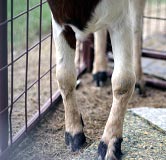
Splay-toed

Post-legged
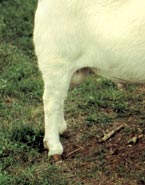
Weak pasterns

Skin cancer
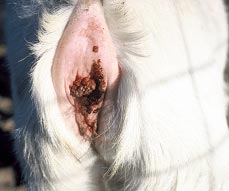
Does
You want a replacement doe to exhibit a feminine head and a feminine wedge appearance to the body with a long elegant neck that blends smoothly into a wide shoulder and back. The doe should project good spring of rib and depth of body which is a good indicator of volume. There should be adequate muscling in the rear leg without losing feminity. The body should have volume and capacity which demonstrates the ability to breed, carry several kids, and rear young in a pasture environment. The external genitalia of the female should be well developed and properly structured. Vulvas which turn up on end can cause a problem when the buck is serving the doe and can result in poor doe fertility.
Does should have well formed udders with good attachment. It is important that the udder is constructed so that the offspring are able to nurse unassisted. The number of functional teats should not exceed two per side with one teat per side as more desirable. Cull faults include udder and teat abnormalities or defects to include, but not limited to, oversized or bulbous teats, and pendulous udder. Other culling characteristics include cluster teats, fishtail teats, or a doe that has not kidded or exhibited signs of pregnancy by 18 months of age. Goats are prolific animals which will naturally reach puberty and be fertile at 6 to 7 months of age. Breeding age females should show evidence of having kidded by the age of two years.
Bucks
You want the breeding buck to show masculinity and exhibit adequate muscling. The head should be masculine with a broad strong muzzle and horns set far apart enough to not rap or break legs of other goats. The neck should smoothly flow into wide smooth shoulders. The body should exhibit a masculine profile with a heavier chest and forebody. Because of manifestation of testosterone, older bucks may demonstrate higher, heavier, and more coarse shoulders.
Bucks must have two large, well- formed, functional, equal-sized testes in a single scrotum. Sperm production is related to the circumference of the testicles. More semen is produced by bucks with greater scrotal circumference. Mature bucks should have a scrotum circumference of 25 cm or 10 inches. In young bucks, testicles should be of equal size and large for day of age. Avoid selecting bucks that exhibit sizeable splits in the scrotum (see photo). Avoid selecting bucks that show overly pendulous testicles. Testicles should be free of bumps or lumps and should be smooth.
Cull faults include single testicle, testicles too small, abnormal or diseased testes, excessive split in scrotum. The teat structure of the buck should also be reviewed as the buck has a large impact on the herd if his daughters are retained as replacements.
Excessive scrotal split
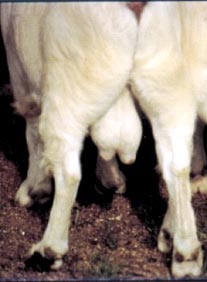
Mouth
The length of the upper and lower jaw should be equal. The teeth should touch the dental pad in young goats. However with older goats some leaning of the teeth is acceptable as long as the length of the jaw and dental pad when viewed from the side is equal. Avoid selecting replacement animals that exhibit undershot jaw (see photo).
Undershot jaw
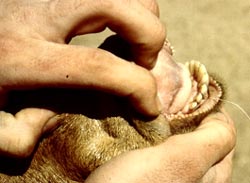
Breeder records
Breeder records can provide valuable insight into the productivity of an animal over its productive life. Utilizing breeder records to meet production goals can enhance selection decisions. Visual appraisal is not always a true indication of how an animal will produce in a goat herd. Basic records should include the following:
- Birth date
- Birth weight
- Animal ID
- Sire
- Dam
- Sex of offspring
- Number born
- Birthing difficulties
- Time of kidding
- Frequency of kidding
- Total pounds of kids weaned
As the animal matures, the breeder can add other records such as health, vaccinations, and marketing results. The resistance to foot rot or internal parasites can also be recorded to aid the producer in identifying superior genetics for future selection and mating. The number of kids born is extremely important, but the number of kids weaned is more important in determining profitability. The number of kids weaned is also related to the mothering ability of the doe and herd management. Time of kidding refers to the days of the gestation period of which is 150 days for goats.
Producers would like every doe to breed in the first cycle. Replacement animals from does that kidded early in the breeding season will be more productive over their lifetime compared to kids from does that did not breed until the third or fourth heat cycles. Recording the frequency of kidding will allow producers to cull does that do not kid every year.
Performance records
Performance records can aid the producer in animal selection and culling. Performance records are recorded at different phases of growth of the animal. Pre-weaning growth rate is how kids grow from birth to weaning and is primarily a function of milk production in the dam. Kids should be weighed at weaning which generally occurs at 60 to 90 days of age.
The total pounds of kids weaned are also important as the total weight of twin kids will be greater than that of a single raised kid. In most cases, the same inputs will be used to produce twins versus a single kid. However, as the number of kids increase, management inputs increase.
Once the kids are weaned they no longer have the dam’s milk to make them grow. They are now depending on their own genetic potential for growth, assuming proper nutrition. This is known as post-weaning growth rate or post-weaning gain. Purebred producers may place buck kids on a gain test to determine post weaning growth rate.
Other performance weights such as birth, 150-day and 365-day weights may aid the producer in making culling and mating decisions.
Genetic evaluation
Although genetic evaluation programs are new to the goat industry, producers of other species have used genetic evaluations for rapid improvement. Most genetic evaluation programs are provided by breed associations and are particular to the breed. Breeders within the breed record individual animal performance measures. Programs predict future performance based on performance of relatives and current performance of the individual animal. Most of the major sheep breeds including Katahdin have a breed improvement program in place and the American Boer Goat Association is evaluating the feasibility of implementing such a program for Boer Goats.
Expected Progeny Difference (EPD) is an estimate of the genetic merit of an animal for a single trait. The purposes of the genetic evaluation programs are as follows:
- Identify and document genetic merit for major economically important traits.
- Predict performance of the next generation.
- Provide breeders with EPDs to be used as another tool in selecting breeding stock.
- Provide the documentation for breeding stock customers to make informed decisions about their purchases.
The expected progeny difference (EPD) for a young animal will be mostly based on his parents’ performance records such as birth, weaning, and(or) yearling weights. After the kid’s own performance records have been processed, his EPD will be based on a combination of his parents’ records and his own performance. If that kid is selected as a breeding animal, and records on his kids are reported, the records on his progeny will also be used to calculate his EPD. Because all relationships (parent-offspring, half-siblings, cousins) among animals are taken into account, records on related animals will be used to improve the accuracy of predictions.
Producers can compare goats using EPDs. For example, a buck with a Weaning Weight EPD of +1.0 is good, but a different buck with a Weaning Weight EPD of +2.0 is better. EPDs give the most objective and reliable estimation of genetic value possible. The EPDs provided by a breed association will vary. The more common EPDs included the following:
- Birth Weight EPD
- Maternal Birth Weight EPD
- 90-Day Weaning Weight EPD
- 150-day Post-weaning Weight EPD
- Maternal Milk EPD
- Milk plus Growth EPD
- Number Born, or Percent Kid Crop
- Carcass EPD
- Reproduction EPD
- Production Life EPD
The breed association calculating the EPDs can provide more information on genetic animal evaluation programs and how to use EPDs as a selection tool to meet production goals.
Heritability
Producers need to consider the heritability of a trait when selecting for genetic improvement. How well a goat performs is due to its 1) genetic makeup, 2) environment; and 3) management. When goats are selected for the breeding herd, the breeder expects that their better production performance will be inherited by their offspring. The percentage of superiority of the parents passed to their offspring is called heritability. Faster progress can potentially be made in improving a trait with a high degree of heritability than in improving a trait with a low degree of heritability. The heritability levels are consider in the following ranges: low 10-20%, moderate 25-45%, and high 50-70%. The heritability values of some economically important traits in goats are in Table 1.
Table 1. Heritability estimates of some economically important traits in goats.
| Trait(s) | Heritability, % |
|---|---|
| Birth interval |
5 – 10
|
| Birth weight |
30 – 40
|
| Number born |
15
|
| Motherability |
40
|
| Weaning weight |
20 – 30
|
| Yearling weight |
40
|
| Mature weight |
65
|
| Milk yield |
25
|
| Milk fat % |
55
|
| Milk protein % |
50
|
| Udder support |
20
|
| Teat placement |
30
|
| Feed conversion |
40
|
| Stature (Conformation & Frame) |
45 – 50
|
| Rear legs |
15
|
| Wither height |
40
|
| Cannon bone circumference |
45
|
| Carcass weight |
45 – 50
|
| Quality grade |
40
|
| Fat depth |
40 – 45
|
| Ribeye (loin) area |
40 – 45
|
| Cutability |
25 – 30
|
| Muscling |
40 – 45
|
| Temperament |
25
|
| Scrotal circumference |
50
|
Next
Module Home
Certification Table of Contents
Browsing Table of Contents
